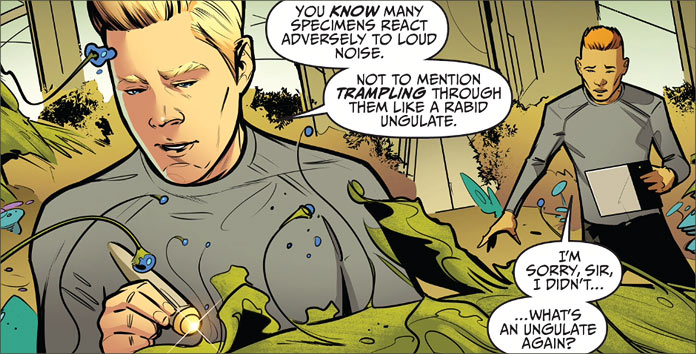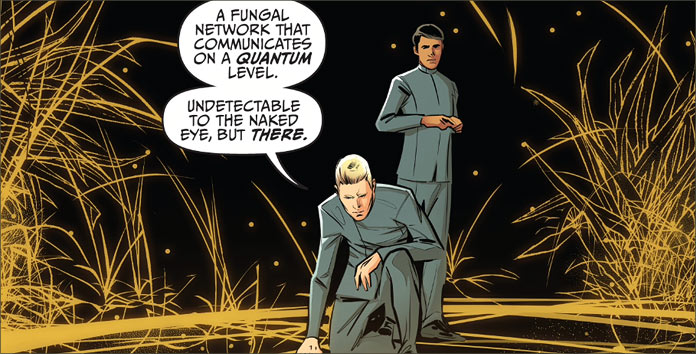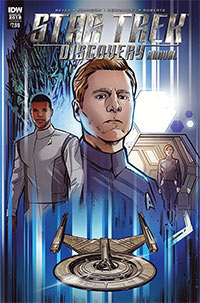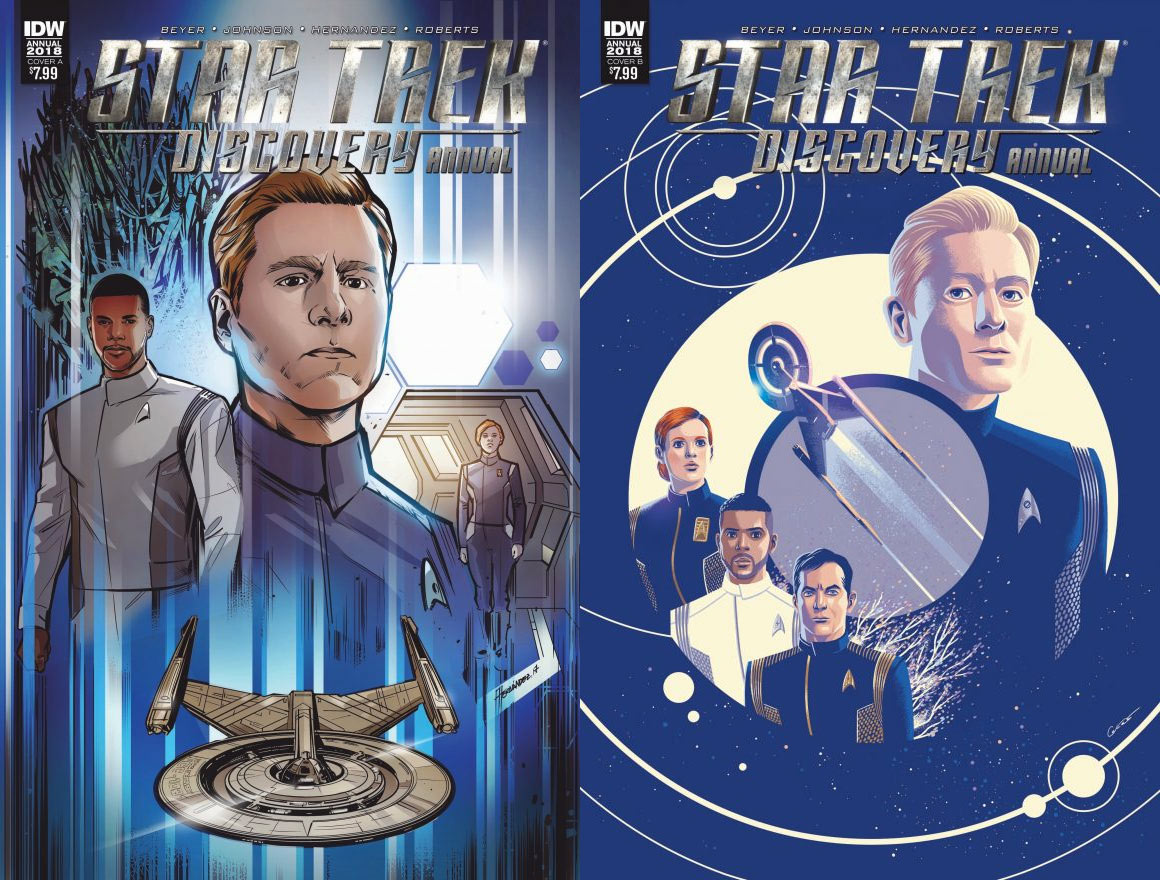I think mushrooms are inherently funny.
Think about it: their contribution to the ecological community is that they break down waste, grow and take up space. So, when the notion of fungus as the source of propulsion for Trek’s newest starship was revealed, I had my arsenal of protist jokes for at least a season’s worth of fungal humour.
I think a lot of Star Trek fans were of the same mind. ‘Astromycology’ is a strange and surprising scientific mixture to work into a new iteration of Trek that was pretty much dumped on the viewer without a lot of explanation in the show, unlike a lot of Trek science.
But then there’s Star Trek: Discovery Annual 2018, written by Kristen Beyer and Mike Johnson, that actually alleviates this oversight with a confident, explorative examination and explanation of the science behind the fungal reasoning for Discovery’s black alerts. I can honestly say that this book puts me in my place and after being exposed to a heightened amount of detailed revelation that explains and eliminates a lot of assumptions I thought I was just supposed to accept, I’m satisfied.
Star Trek: Discovery Annual 2018 looks at the origins of the research — and the researchers — who discovered the unique fungus that is behind the spore drive. There are also a lot of notions about Lieutenant Paul Stamets that were introduced in this comic that I had not considered. For example, he isn’t a career Starfleet officer; that was the first assumption I thought I should just go along with in the show.

If it was mentioned, I missed it. According to Star Trek: Discovery writer and veteran Star Trek comic writer, Mike Johnson, he was about as pure a research scientist as one could expect and his indoctrination into Starfleet was about as welcome as putting on a scratchy uniform. But that’s the advantage of having a writer with ties to the show, which begs the question, as Kristen Beyer is one of the Disco writers; should we consider this canon?
(This is the type of question that keeps me up. Well, that and I’m trying to figure out exactly what the division of writing is between Beyer and Johnson.)
Fifty pages plus, filled with revealing background of characters we already know like Stamets, Cadet Sylvia Tilly, and Dr. Hugh Culber, but then there are the characters we don’t know. Stamets’ research partner, Justin Straal, who we briefly saw in “Context is for Kings” before his untimely demise, was the other research half responsible for the spore drive.
This book gives more of a voice to that character (played in the episode by by Saad Siddiqui) and allows us to learn more about the human side of the spore drive’s development and the sacrifice behind it.

We also learn more about Stamets’ personality and the beginnings of his relationship with Culber. First of all, Stamets is not just an unlikeable person… he is a thoroughly unlikeable individual whose harsh and unwelcoming exterior actually masks a frightened and insecure personality.
As the research into the particular fungus responsible for the spore drive, stellaviatori, develops throughout the story, not only do we learn more about Stamets the character, but also about the quantum theory about the fungi, and the moment of inspiration that allowed Stamets and Straal to experiment with its propulsive applications.
Sylvia Tilly, one of my least favourite characters from Discovery’s first season, also gets some minor attention in this issue. Background work, to be sure, but while this fawning, socially awkward, second-rate, Starfleet wannabe adds little value to the crew (in my opinion), at least we now understand why she is on board one of Starfleet’s most advanced vessel. Her devotion to Stamets’ research makes her an excellent assistant and the justification for her presence on the show is also explored and identified in this comic.
Dr. Culber gets more face time as well. Though, his only story value is to provide a comforting relationship to Stamets. It’s clear that Stamets is a complicated character whose need for a nurturing partner can be concentrated in just one person. He describes Culber as “perfect” in this book, and that insight lends more validity to the relationship we see on the show.
The covers are limited for this book, only two designs, but quality rules over quantity here.
- Angel Hernandez provides the ‘A’ Cover, as well as the interior art, and it’s definitely representative of high-quality work. Well-defined and enjoyable, it’s art that captures the emotional resonance of the characters. Anthony Rapp’s facial expressions and haughty attitude are well-captured, adding to the pleasure of reading this book.
- Cover ‘B’ is by George Caltsoudas, another of IDW’s staple cover artists. Caltsoudas has a more figurative style and usually goes for more stylistic works, but this issue is very much in the same portrayal format as Hernandez’s cover. He matches Hernandez’s likeness standard and also presents a very enjoyable cover.
- The final cover is a blank ‘convention’ cover, which will allow comic readers to obtain their own sketches by artists of their own choice at various conventions.
In the end, this is a thoroughly entertaining and informative read that reinforces the notion that the spore drive and Stamets are inseparable. Their connection becomes that much more physical as we see in the development of the television show, but this comic explores the background of its creation and reinforces to us exactly how indispensable the character is to the latest incarnation of Star Trek.

Beyer and Johnson have given us a detailed look at the scientific rationale behind the spore drive, greater insight into the characters responsible for its operation and maintenance and now I need to know if Star Trek: Discovery Annual 2018 will be regarded as canon?
Hmm… all of a sudden, mushrooms just became a lot less funny.


